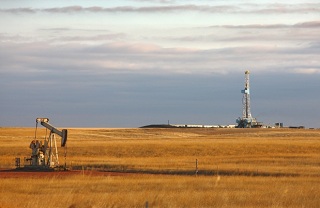U.S. is poised to become oil powerhouse, forcing Canada to seek new markets
 The International Energy Agency forecasts that the U.S. will be the world’s largest oil producer by 2017, highlighting the need for Canada’s oil and gas sector to gain access through B.C. to growing Asian markets, Scotiabank’s commodity analyst Patricia Mohr warned Monday.
The International Energy Agency forecasts that the U.S. will be the world’s largest oil producer by 2017, highlighting the need for Canada’s oil and gas sector to gain access through B.C. to growing Asian markets, Scotiabank’s commodity analyst Patricia Mohr warned Monday.The surge in American production threatens Canadian energy exports to the U.S., which imports virtually all of Canada’s oil, she said. Canada is America’s largest oil supplier, accounting for about 28 per cent of all U.S. imports, according to the U.S. Energy Information Administration.
“It is absolutely critical that we build pipeline capability for Canada’s oil industry to the B.C. coast,” she said.
A new IEA report, World Energy Outlook 2012, says that North America is leading a profound shift in the global energy market thanks to the recent development of horizontal drilling and hydraulic fracturing of oil-rich shale deposits in places like North Dakota, Montana, and, to a lesser extent, Saskatchewan.
The world energy map is being redrawn by resurgent oil and gas production in the U.S., according to the report by the Paris-based agency, an adviser on issues like energy security to 28 nations.
To put the scale of the oil transformation in context, the IEA says that by 2017, U.S. production is expected to surpass that of Saudi Arabia, and the major energy consumers will be Asia’s growing economies.
“Around 2017, the U.S. will be the largest oil producer of the world, overtaking Saudi Arabia,” IEA Chief Economist Fatih Birol said at a press conference in London Monday. “This is of course a major development and definitely will have significant implications.”
The implications go beyond economics. Despite the new developments in oil production brought about by new technologies, the IEA says the global energy system is still far from being on a sustainable path. Energy demand is expected to rise by one-third globally by 2035, with Asian nations accounting for most of that. Demand barely rises at all in the 34 Organization for Economic Co-operation and Development countries.
The World Energy Outlook report notes that fossil fuel remains the world’s dominant energy source. In 2011, fossil fuel production received subsidies of $523 billion US, six times more than the subsidies for renewable energy. The momentum for reform of the subsidies, mostly in Middle Eastern and North African nations, appears to have been lost, the report states, and the world is on a long-term path for an average global temperature increase of 3.6 degrees C.
In terms of markets, as the U.S. moves from being a net importer to a net exporter of energy, and Asia’s demand for energy grows, the entire global flow of energy is expected to shift. Middle Eastern oil nations are expected to switch their exports from Western economies to Asia, the report states.
The U.S. — which currently imports 20 per cent of its energy needs — will be energy self-sufficient by 2035.
But don’t expect to wait that long to feel the impact of such a dramatic sea-change in global energy supply, Mohr said.
“The U.S. is reducing its reliance on imports quite phenomenally, and if we don’t build pipelines like Northern Gateway, or the expansion of the Trans Mountain pipeline into Burnaby, I think we are going to stunt the growth of the oil industry in Western Canada. I think this will become self-evident very quickly — in about three years’ time.”
Investors in Canadian oil stocks are likely to be the first to feel the impact, she said.
“You are going to find shortly that this bears on the actual return on shareholders’ equity for Canadian oil stocks. This is not something that has airy-fairy implications. It is quite real,” she said.
She said ironically, bitumen from the Alberta oilsands, which has a ready market in U.S. Gulf Coast refineries, will likely be affected less than the rest of the western Canadian oil and gas sector, which produces light crude called western Canadian Select, similar to the light crude being produced through horizontal drilling and fracking technologies in the U.S.
“Light crude oil prices, by mid-decade, will start to be discounted,” she said.
Mohr, who writes a monthly commodity price index report for Scotiabank, prepared a supply-side look at North American oil and gas over the next five years in the Oct. 29 edition of the index.
In it, she said the 75 per cent of all non-OPEC supply increases between now and 2017 are projected to come from the U.S. and Canada, specifically from multi-fractured drilling technology — which is the source of light oil and natural gas liquids such as propane and ethane in the U.S. — and from the Alberta oilsands.
You can return to the main Market News page, or press the Back button on your browser.

